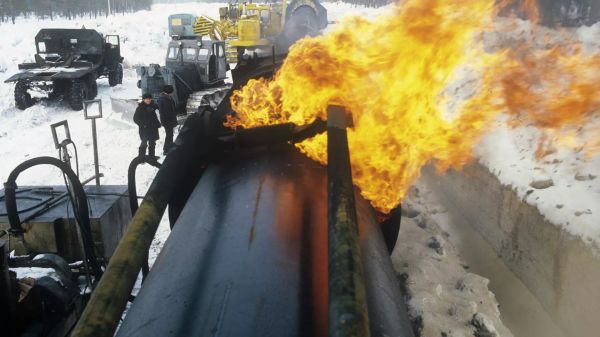Blasts rocked the Nord Stream 1 and 2 natural gas pipelines on Monday, with each pipeline reportedly hit with the force of over 500 kg of TNT – which when combined is equivalent to the explosive power of a micro nuke.
The Kremlin called the incident an act of terrorism, while Russian intelligence has pointed to a Western trace.
In his address before lawmakers and the nation on Friday on the entry of four new territories into the Russian Federation, Vladimir Putin said that the attacks against Nord Stream were the next logical step for the US and its allies after exhausting anti-Russian sanctions. “It seems incredible but it is a fact – by causing explosions on Nord Stream’s international gas pipelines passing along the bottom of the Baltic Sea, they have actually embarked on the destruction of Europe’s entire energy infrastructure,” the Russian president said.
Everything Old is New Again
The attacks against Nord Stream are not the first time that a ‘Western trace’ has been suspected in the sabotage of gas pipelines operated by Moscow.
In the summer of 1982, the Urengoy-Surgut-Chelyabinsk pipeline carrying natural gas south and west toward Ukraine, where it can be taken further west toward Europe, was rocked by a massive explosion. The explosion’s causes were unknown, and Soviet media never reported on the incident.
In 2004, former Reagan special assistant for national security affairs and National Security Council official Thomas Reed published an autobiography entitled ‘At the Abyss’ in which he alleged that the Central Intelligence Agency had sabotaged the pipeline by adding a virus into software the USSR had purchased from a Canadian company to operate the infrastructure.
“The pipeline software that was to run the pumps, turbines and valves was programmed to go haywire, to reset pump speeds and valve settings to produce pressures far beyond those acceptable to the pipeline joints and welds. The result was the most monumental non-nuclear explosion and fire ever seen from space,” Reed recalled.

Portions of the operation were disclosed earlier, in a 1996 paper in CIA journal Studies in Intelligence by Weiss. In it, the former official recalled how, at an economic summit in Ottawa in 1981, French President Francois Mitterrand had informed Ronald Reagan that a KGB double agent named Vladimir Vetrov had come forward to provide French intelligence with 4,000 documents and photographs related to alleged Soviet efforts to get their hands on Western technologies which the US and allies refused to sell due to sanctions and embargoes. The collection of documents was dubbed the ‘Farewell Dossier’.
In January 1982, Weiss said, he proposed the pipeline sabotage idea to CIA director William Casey. “Reagan received the plan enthusiastically” and “Casey was given a go,” Reed wrote in his account.
As has long been the case with the Nord Stream pipelines, the United States had adamantly opposed Soviet projects to deliver gas from Siberia to Western Europe, characterizing them as a means for Moscow to project influence over the Europeans. In 1982, the Reagan administration banned pipeline equipment sales to the USSR, prompting the European Economic Community – forerunner to the European Union, to issue a formal protest over Washington’s interference in the bloc’s economic affairs. Germany, France, Italy and the UK declared the restrictions illegal, and promised to defy the ban. Washington eventually reneged, and the first gas deliveries from Urengoy to Western Europe began in January 1984.

To this day, Russian officials have never conceded that the 1982 explosion was the result of CIA interference. In the 1990s and 2000s, when relations between Russia and the US still looked rosy, engineers and ex-KGB agents came forward to tell media that industrial negligence or even shoddy workmanship, and not sabotage, was to blame.
The CIA never directly confirmed its involvement in the Urengoy-Surgut-Chelyabinsk pipeline explosion. However, in a page on the CIA’s official website, the agency did boast that “flawed turbines were installed on a gas pipeline” as part of a broader US technological sabotage campaign against the USSR.
Author
Ilya Tsukanov is a Moscow-based correspondent specializing in Eastern European, US and Middle Eastern politics, Cold War history, energy security and military affairs. Member of the Sputnik team since the site's inception in 2014.






